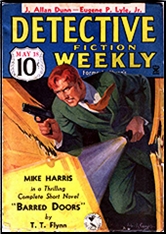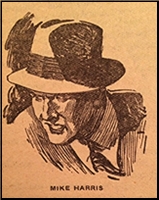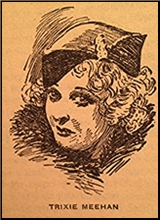Thu 6 Jun 2019
Pulp PI Stories I’m Reading: T. T. FLYNN “Barred Doors.”
Posted by Steve under Pulp Fiction , Stories I'm Reading[7] Comments

T. T. FLYNN “Barred Doors.” Short novel. Mike Harris & Trixie Meehan #7. First appeared in Detective Fiction Weekly, May 18, 1935. Probably never reprinted.
I may be wrong, but whenever female private eyes have come up for discussion on this blog, especially those who primarily appeared in the pulp magazines, the name Trixie Meehan has never been mentioned. It’s true that she always played second fiddle to Mike Harris, her fellow operative for the Blaine Agency, but she’s her own woman with her own cases, and the fact that every so often she’s able to give Harris a helping hand is no reflection on her ability.
In “Barred Doors” Harris is given the job of tracking down the secretary who seems to have disappeared with a half million dollars worth of unregistered Liberty bonds taken from the safe of the agency’s client, Sir Douglas Carter MacClain.

Naturally there is a gangster involved and the gangster’s ex girl friend, who has lately been seen gong out on the town with the missing secretary. There is a kidnapping involved, and a strange form of blackmail, or so it is revealed, but with both Mike Harris and Trixie Meehan on the case, everything eventually works out justice finally prevails.

The story is suitably complicated and well told, but to me, there’s just not enough zip to it to make it more than just a step above average, but above average it most certainly is. There doesn’t seem to be anything of a romantic nature between Mike and Trixie, just a lot of light bickering and back-and-forth banter, nothing more serious than that.
Having sold off a large number of my DFW collection, I may not get a chance to read another of their adventures, but I’d like to. There were sixteen of them between 1933 and 1951, all but the last published in Detective Fiction Weekly. That final one appeared in Detective Tales, some ten years after the previous one. (It is possible that this last one is a reprint of an earlier story under a new title.)